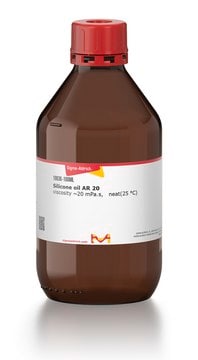추천 제품
일반 설명
Silicone oil AP 150 is a conventional electrorheologic (ER) fluid. It was employed as an insulating medium during the poling of hard ferroelectric ceramics. Silicon oil is composed of a mixture of hydrophobic polymeric and monomeric compounds, containing silicon-oxygen bonds. Its physical and chemical characteristics have been reported. The utility of silicon oil as a vitreous substitute has been studied.
애플리케이션
Silicone oil AP 150 was used to prevent the water evaporation during rheological characterization of injectable polysaccharide system based on calcium alginate hydrogel and two dextran methacrylate derivatives. It may be used for the determination of chloroplast volume by the silicone oil filtering centrifugation technique.
Storage Class Code
10 - Combustible liquids
WGK
WGK 3
Flash Point (°F)
437.0 °F - closed cup
Flash Point (°C)
225.00 °C - closed cup
개인 보호 장비
Eyeshields, Gloves
시험 성적서(COA)
제품의 로트/배치 번호를 입력하여 시험 성적서(COA)을 검색하십시오. 로트 및 배치 번호는 제품 라벨에 있는 ‘로트’ 또는 ‘배치’라는 용어 뒤에서 찾을 수 있습니다.
이미 열람한 고객
L Pescosolido et al.
European biophysics journal : EBJ, 39(6), 903-909 (2009-03-28)
A novel injectable polysaccharide system based on calcium Alginate (Ca-Alg) hydrogel and two Dextran methacrylate derivatives (DexMA) was recently developed. The resulting Interpenetrating Polymer Network showed a synergistic mechanical behavior that can be exploited to target the hydrogel properties towards
S P Robinson
Plant physiology, 79(4), 996-1002 (1985-12-01)
Spinach leaf chloroplasts isolated in isotonic media (330 millimolar sorbitol, -1.0 megapascals osmotic potential) had optimum rates of photosynthesis when assayed at -1.0 megapascals. When chloroplasts were isolated in hypertonic media (720 millimolar sorbitol, -2.0 megapascals osmotic potential) the optimum
Silicone Oil: Different Physical Proprieties and Clinical Applications.
Barca F, et al.
BioMed Research International, 2014 (2014)
F Aliotta et al.
Physical review. E, Statistical, nonlinear, and soft matter physics, 87(6), 062304-062304 (2013-07-16)
The influence of interactions between particle surface and host fluids in electrorheological suspensions is explored. It is observed that dispersions of nanosized particles of titania in octanoid acid exhibit an anomalously large electrorheologic effect when compared with a similar dispersion
Poling of hard ferroelectric PZT ceramics.
Kamel TMand de With G.
J. Eur. Ceram. Soc., 28(9), 1827-1838 (2008)
자사의 과학자팀은 생명 과학, 재료 과학, 화학 합성, 크로마토그래피, 분석 및 기타 많은 영역을 포함한 모든 과학 분야에 경험이 있습니다..
고객지원팀으로 연락바랍니다.




